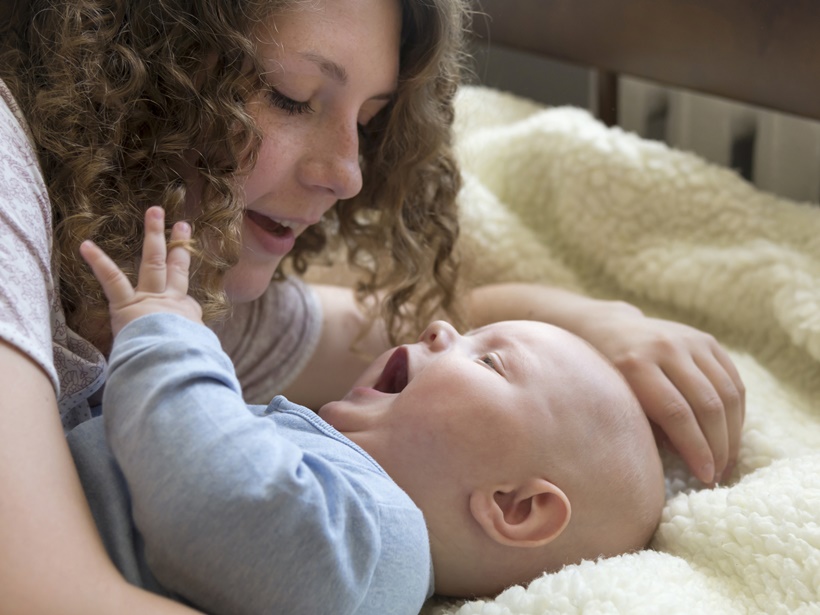With rich stimulation in communication, by the time your baby reaches three years of age, a “language burst” occurs.
By Abha Ranjan Khanna
Research has revealed that the human foetus responds to sound as early as 19 weeks of gestational age and all foetuses respond to sound/music/talk by 33 and 35 weeks of gestational age. This indicates that the apparatus of hearing, the cochlea, matures rapidly from the 19th week onwards and wires the infant for speech and hearing. Parents can make the most of these early years.
Essentially, the first three years of life are a critical period for language development. During this time, an infant communicates constantly, but not with words. The ability to communicate develops sequentially and more advanced skills build onto a foundation of earlier skills, just like motor skills.
Within three years, children grow from beings whose main language is crying to little persons who can debate with their parents!
According to the American Speech and Hearing Association the progression of hearing, speech and understanding happens as follows:
Hearing and Understanding
Birth–3 Months
- Startles at loud sounds.
- Quiets or smiles when you talk.
- Seems to recognise your voice. Quiets if crying.
4–6 Months
- Moves her eyes in the direction of sounds.
- Responds to changes in your tone of voice.
- Notices toys that make sounds.
- Pays attention to music.
7 Months–1 Year
- Turns and looks in the direction of sounds.
- Looks when you point.
- Turns when you call her name.
- Understands words for common items and people—words like cup, truck, juice, and daddy.
- Starts to respond to simple words and phrases, like “No,” “Come here,” and “Want more?”
- Plays games with you, like peek-a-boo and pat-a-cake.
- Listens to songs and stories for a short time.


Talking
Birth–3 Months
- Makes cooing sounds.
- Cries change for different needs.
- Smiles at people.
4–6 Months
- Coos and babbles when playing alone or with you.
- Makes speech-like babbling sounds, like pa, ba, and mi.
- Giggles and laughs.
- Makes sounds when happy or upset.
7 Months–1 Year
- Babbles long strings of sounds, like mimi upup baba.
- Uses sounds and gestures to get and keep attention.
- Points to objects and shows them to others.
- Uses gestures like waving bye, reaching for ‘up,’ and shaking his head no.
- Imitates different speech sounds.
- Says 1 or 2 words, like hi, dog, dada, mama, or uh-oh. This will happen around his first birthday, but sounds may not be clear.
Also Read: Early Childhood Intervention: Nutrition and feeding routines
Simple strategies to stimulate language development in these critical early years include:
* Talk to your baby from Day One! Tell her how much you love her, tell her about her little body parts as you bathe her, tell her how beautiful her eyes are and what colour they are while making eye contact at all times that you are talking to her.
* Sing to your baby as you hold her during breastfeeding, sing to her as she wakes up in the morning and at every nap time.
* Play soft music in the background during the day.
* Practice responsive care giving and respond to your babies cry and other sounds she makes as quickly as possible with understanding what she is trying to communicate. You will get better every day and this helps bonding and emotional trust.
* As she grows, talk her through the activities you are doing together, use rich language and dramatic storytelling.
Model words for her gestures – “water – you want water”, give her choices “you want to play with the doll or look at a book?”
* Name all the objects in the environment that she sees, talk about family members and room in the house.
With this rich stimulation in communication, by the time your baby reaches three years of age, a “language burst” occurs. This is when she will demonstrate rapid growth in language and speech skills. She will expand her vocabulary, start to make longer sentences, try out new parts of grammar, answer questions more specifically, follow longer directions, and practice conversation skills. Enjoy!
(The writer is an occupational therapist.)
Source: Read Full Article



